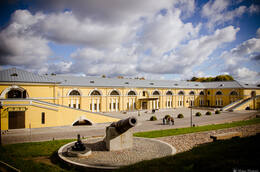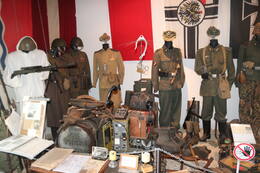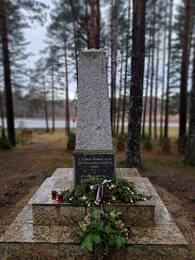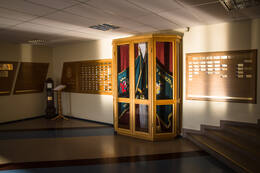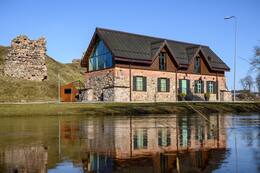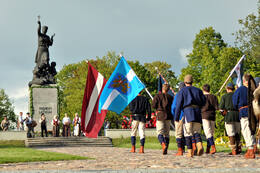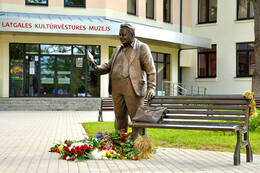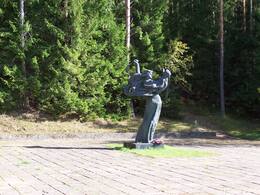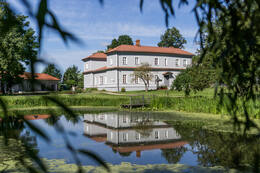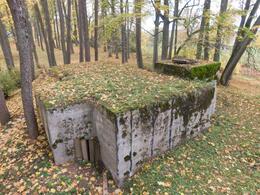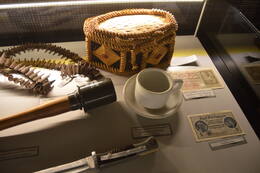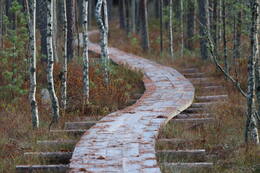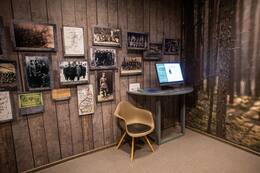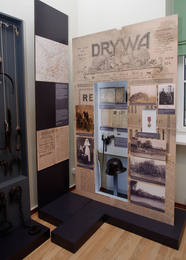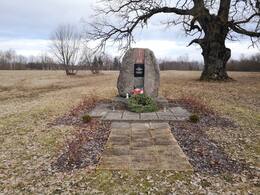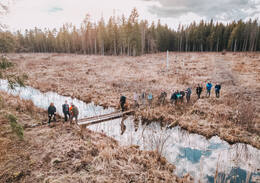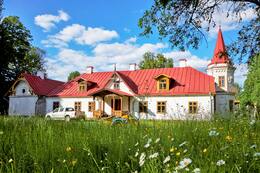Latgale – the Eastern Border of Latvia
Daugavpils Fortress
Daugavpils Fortress is an architectural, cultural and historical heritage monument of national importance. It is the last bastion-type fortress built in the world and the only surviving example of a fortress from the first half of the 19th century in Central Europe, which has been preserved without significant changes.
Its construction began in 1810, as Tsarist Russia prepared for Napoleonic invasion, and continued until 1878. In 1812, Russian and French troops fought at the unfinished fortress. After the Napoleonic Wars, the construction of the fortress continued, however, already during its construction, it began to lose its military importance.
During World War I (1915–1918), the fortress served as a support and logistics base for the Russian Army. In February 1918, it was occupied by German troops, and in December – by Bolshevik forces. In January 1920, the fortress was recaptured by Polish troops, who helped the Latvian Army to liberate Latgale from the Bolsheviks. From 1920 to 1940, the 4th Zemgale Division of the Latvian Army was stationed in the fortress.
After the occupation of Latvia in 1940, Red Army units were stationed at the fortress, and during the German occupation, it became the site of the prisoner-of-war camp for Red Army POWs “Stalags-340”. After the second Soviet occupation in 1944, Soviet troops were again stationed in the fortress. Latvia regained the fortress in 1993 after the Russian Army had left.
Daugavpils Lead Shot Factory
The Daugavpils Lead Shot Factory, founded in 1885, is the oldest ammunition factory in Northern Europe, the only factory of its kind in the Baltic states, and one of the oldest industrial heritage sites in Latvia. It is home to Europe’s only operational lead shot tower.
Over the centuries, the factory has been producing high quality hunting shots and continues to do so today. The factory preserves equipment and structures from the 19th century, which have been supplemented before and after the World Wars. Modern equipment is used to produce ammunition.
Visitors can see the historical exhibition and the shot casting workshop, as well as climb the unique 31.5-metre-high tower of the plant, beneath which a 13.5-metre-deep cooling well is situated. This factory is a popular tourist destination that attracts both local and foreign visitors, enabling them to discover the industrial heritage of the 19th century and see the old machinery in action. After the factory tour, visitors can test the products made at the shooting range of the factory
WW2 – World War II Exhibition
WW2 – World War II exhibition in Aglona or the War Museum was established in 2008 and is one of the most extensive and interesting expositions of this kind in Latvia. The collection has been continuously supplemented with new acquisitions and stories of war participants and people of the wartime generation.
The core of the museum consists of weapons, equipment, ammunition, and uniforms used during World War II. In addition, there are household objects, fragments of aircraft wrecks and other exhibits. One of the most precious and unique exhibits is the Feldpost (field post) correspondence between Oberleutnant August and his lover Martha, which created a dialogue between two loving people with a happy ending during the period of the five years of war. Wartime chronicles are displayed in the background of the exhibition.
The exhibition is not politicised and reflects both sides of the war equally, allowing viewers to perceive it without making judgements of good or bad, which makes the exhibition easy to understand.
Monument to the Latvian Freedom Struggles at the site of the battles of the 3rd Jelgava Infantry Regiment
Monument to the 3rd Jelgava Infantry Regiment's January 16, 1920, freedom struggle in Latgale. With the inscription: “The place of the 3rd Jelgava Infantry Regiment's battles, the victory march through Latgale. 1920.16.I. We brought the sun, freedom and independence to Latvia”
The monument was unveiled in 1936. On August 16, General Žanis Bachs (1885–1941) consecrated it by Pastor Ādams Vizulis (1891–1970). The author of the monument's design was Engineer Zilēvičs.
The Latvian War of Independence (1918–1920) operation to liberate Latgale began on January 3, 1920. By mid-January, the Latvian and Polish armies had liberated Daugavpils and most of southern Latgale up to the Dagda–Indra line from the Bolshevik forces that had seized power in Russia. On January 9, the Latvian army began its offensive in Northern Latgale, rapidly advancing towards the Kārsava and Pitalova stations.
In the middle between the two directions of attack remained the Bolshevik-controlled area around Varakļāni, Viļāni and Rēzekne. On January 20, Latvian army units began the operation to liberate Rēzekne. Rēzekne was liberated on January 21. The Latvian army, across the entire expanse of the Eastern Front, reached the border of Latvian-inhabited lands by the end of January. Already on February 1, Soviet Russia signed an armistice agreement with Latvia.
With the victory in the Battles of Latgale, Latvia's eastern border was secured and the opportunity to annex Latgale to Latvia was gained. The Latvian army achieved the final unification and independence of Latvia in 1920.
The monument, dated 1920.16.I., is dedicated to the moment when the 3rd Jelgava Infantry Regiment took up its starting positions before the operation to liberate Rēzekne.
Border Guard Museum
The museum is located in the premises of the State Border Guard College of Latvia in Rēzekne.
The museum houses an exhibition of the Border Guard History Research Unit, which reflects the chronological development of the Latvian Border Guard from 1919 to the present day. The collected objects and photographs tell the story of the service and everyday life of Latvian border guards in the period from 1919 to 1940, and also about the tragic fate of the border guards after the occupation of the country in 1940. At that time, border guards, along with their relatives, were among the first to be repressed. The museum displays evidence of the service of the restored Border Guard after the restoration of the independence of Latvia – uniforms, equipment, awards and insignia, which have been undergoing continuous development and change even nowadays.
A visit to the Cynology Centre, where you can watch demonstrations by service dogs, is an integral part of the tour.
Appointments must be made in advance.
Free State Treasure House
The Treasure House of the Free State is located next to the Rēzekne Castle ruins.
The unique exhibition includes hundreds of different historical testimonies from Latvian and foreign private collections, covering the period from 1918 to 1940, revealing the events in the history of Latgale and Rēzekne. It presents the history of military and civilian awards of the First Free State of Latvia, as well as various organisations related to the activities of state and civic organisations in the period from the Latvian War of Independence to World War II.
The collection of military and civilian awards and insignia of the Latvian Free State on display here is the largest one in Latvia.
The Changing Exhibition Hall is situated on the second floor, where a new exhibition is held at least once per year. To date, visitors have had the opportunity to see a unique collection of porcelain objects, luxury clocks from France and paintings depicting various landscapes of Latgale.
Monument “Vienoti Latvijai” (“United for Latvia”) or Māra of Latgale
The Monument “Vienoti Latvijai” (“United for Latvia”) or Māra of Latgale is located in Rēzekne. Its central image of a woman holding a cross in her hand symbolises the Latgale region of Latvia, which was liberated from Bolshevik rule in 1920, and its spirit of Christian civilisation.
The monument was initiated by public figures of Latgale in the 1920s. The foundation stone was laid and consecrated on 8 June 1930. In June 1934, a competition for the design of the monument was announced, and the design by Kārlis Jansons won the com petition. The monument was unveiled on 8 September 1939, and the consecration service was held by Bishop Jāzeps Rancāns.
After the Soviet occupation in November 1940, the monument was pulled down. The bronze sculptures were not destroyed due to a shortage of time and the monument was restored on 22 August 1943, during the German occupation. When the Soviet occupation returned, the cross was initially sawn off, while, in 1950, the monument was completely destroyed.
During the Soviet occupation, a Lenin monument was erected instead, which was removed immediately after Latvia regained its independence in 1991.
During the Awakening in 1989, the idea of restoring the historical United for Latvia monument was born. The monument was recreated by the sculptor Andrejs Jansons, the son of Kārlis Jansons, in collaboration with Inta Folkmane, based on his father’s materials and photographs. The restored monument was unveiled on 13 August 1992, during the First World Gathering of Latgalians.
Latgale Culture and History Museum
Three permanent exhibitions are on display at the Latgale Culture and History Museum in Rēzekne. One of them – “Rēzekne laikmetu griežos” (Rēzekne through Ages) – tells the story of the history of the city over seven centuries. A significant part of it is devoted to the events, wars and changes of the 20th century: World War I, the War of In dependence, World War II, the destruction of Rēzekne in 1944 by the Soviet bombers, as well as the prisoner-of-war camp Stalag 347. The exhibition includes a photo booth about the fates of the soldiers from Rēzekne during the war.
During the period of the free state of Latvia, the soldiers of the 9th Rēzekne Infantry Regiment of the Latvian Army stationed in Rēzekne were an integral part of the public life of the city and sporting events, especially during the celebrations of the 11th and 18th of November.
Ančupāni Memorial to the Victims of the Second World War
The memorial is located in Ančupāni, in the vicinity of Rēzekne. It was created to commemorate the tragedy of Audriņi – the extermination of civilians during the Nazi German occupation, which took place in 1942 in the village of Audriņi, Makašāni Parish, Rēzekne County.
From the autumn of 1941, several Red Army prisoners of war who had escaped, hid in Audriņi. On 18 December 1941, their whereabouts were discovered and four auxiliary police troops were killed in clashes. On 24 December, 203 residents of Audriņi were arrested and imprisoned in Rēzekne Prison. On 3 January 1942, most of the arrested were shot near the Ančupāni Hills, about 5 km from Rēzekne, and on 4 January, 30 men, arrested in the village of Audriņi, were publicly shot in the market square of Rēzekne, and the village itself was burnt down. The memorial was unveiled on 27 July 1974. It was designed by landscape architect Alfons Kišķis (1910–1994). The evergreen spruce trees on the right side of the road symbolise people lined up to be shot, while the stone wall on the opposite side of the road represents the shooters. In the lowest part – the Valley of Suffering – a boulder-strewn path leads past the mass graves of the people who were shot, ending at a concrete wall with the inscription: “They died so that you might live.” Then, the stairs leading to the Square of Life follow, with the central sculpture “Mother Apple Tree” by sculptor Rasa Kalniņa-Grīnberga (1936) in the square.
Exhibition “Ludza Region 1918–1945. May Latvia live forever!” at the Ludza Regional Studies Museum
The Ludza Regional Studies Museum’s exhibition “May you live forever in Latvia! 1918–1945” reflects an important historical stage in the development of Eastern Latgale from 1918 to 1945. The exhibition features various relics from this historical era. Among them are items that once belonged to R. Kalniņš, a Ludza resident and participant in the Freedom Struggle. The artistic design of the space allows visitors to feel the atmosphere of the time when a wave of mass deportations swept across Latvia. The central relic that depicts this historical stage is a wooden cross made by the repressed Catholic priest Kazimirs Vitanis. The installation of the World War II battlefield creates an emotionally vivid atmosphere of that time. Visitors to the exhibition can also get acquainted with the war awards of the Soviet Army and the German Army. The old photographs of Ludza shown in the exhibition give visitors an idea of the image of the city before and after World War II.
Repository of Historical Evidence in Līdumnieki
The Līdumnieki War Exhibition, or the Municipal Repository of Historical Evidence in Līdumnieki, is located in the former kolkhoz council building in Zabalotjes Manor Park, which is situated in the centre of the village of Līdumnieki (Zabalotjes/Aizpūre) of Līdumnieki Rural Territory.
The exhibition was created thanks to the local enthusiasts – patriots of the village, who have placed their personal collections and relics donated by local people in the historical building.
The exhibition consists of three parts. The largest part of the exhibition, which is also the central space, is dedicated to World War II. It features details of tanks, cannons, aircraft, models of equipment and weapons of soldiers of different armies, as well as everyday and warfare items of soldiers: flasks, dixies, helmets, uniforms, insignia, ammunition boxes, and models of mines.
The second part of the exhibition features evidence dating back to 1941. The exhibition includes household objects, various original documents, textbooks, notebooks, letters, newspapers, magazines, and similar materials of Ludza County residents.
The third part of the exhibition gives an insight into the life, aims and activities of the “Līdumnieki” collective farm.
World War II Bunkers in Malnava and Hitler’s Visit to the Headquarters of the German Army Group North
Hitler’s visit to the Headquarters of the German Army Group North in Malnava and the air defence bunker are mentioned as related sites. However, apart from the location – Malnava Manor, there is no other link between them.
From 12 to 28 July 1941, the headquarters of the German Army Group North, which was waging an attack against Leningrad, was located in Malnava Manor. The reason for the choice of location was practical: Malnava Agricultural School, which was located in a former manor house, had modern facilities: electric lighting, centralised water supply, showers, and sewerage. The headquarters of Group North was located in one of the side blocks of the manor, while the rest of the building continued to operate as an agricultural school. Hitler’s visit to the Group North headquarters in Malnava took place on 21 July 1941. Hitler and his entourage arrived in two Junkers aircraft, accompanied by nine Messerschmitt fighters. The visit only lasted for a few hours and is immortalised both in German military newsreels from the front and in the memories of the pupils of Malnava.
The air defence bunker, located about 70 metres from the manor house, was built at the beginning of 1944 when Soviet aviation began to dominate the airspace in the second half of the war. At that time, the retreat process of German troops was in progress. In 1944, the Headquarters of the German Army Group North stayed in Malnava from February to mid-July.
Private Exhibition “Abrene Rooms”
The Private exhibition “Abrene Rooms” is located in the town of Viļaka, in a building with a diverse history. Initially, the building was located on the old Marienhausen market square, later it housed apartments, offices and various shops, and during World War II, it was the Latvian self-defence headquarters, the Gestapo and also the Cheka. Several exhibitions reveal diverse events and historical periods in the town of Viļaka and its nearest vicinity covering the time period from 1920 to 1960 when Viļaka was part of Jaunlatgale, later Abrene, district. The exhibit features items from the national partisan camp in Stompaki Swamp, which are related to the national partisan movement in the Latgale region. Documents and photos associated with the War of Independence are also on display. The latest exhibition is dedicated to the once-famous motocross track “Baltais briedis”.
Vilaka Museum
Viļaka Museum operates in two buildings – the Catholic parish house, built in 1913, which is an important cultural heritage object of the town, and the other building of the museum – a former monastery of Capuchin monks, whose cellars are closely related to the national partisan movement in Stompaki and the Soviet Cheka. According to the memories of the locals, people were held and tortured in these cellars. The old museum building houses several exhibitions, with one of the exhibitions dedicated to the 1920 freedom battles in Northern Latgale, and the second – to the events of the Second World War – the Jewish Holocaust in Viļaka and information about the families who were shot. More information about each family is available based on their street address.
The exhibition is supplemented by information about the national partisan movement in Stompaki – various testimonies, photographs and objects. Visitors can learn about the military heritage sites in and around Viļaka, such as the Freedom Fighters Monument in Jaškova, which was demolished during the Soviet era and restored in 1990, and the stele dedicated to the recipients of the Order of Lāčplēsis. The sound of World War II aircraft is incorporated into the exhibition of the museum, as the German Luftwaffe airfield was located near Viļaka. The museum offers an opportunity to see some memories of the Second World War events in Viļaka, as well as to receive information about the German prisoner-of-war camp in Rači.
Trail and partisan memorial in Stompaki bog
During World War II, one of the largest national partisan camps in the Baltic states was situated in Stompaki Swamp. Today, the territory is included in the nature reserve “Stompaki swamp”. The settlement sites located on the islands in the swamp can be reached via a marked footpath.
In early 1945, about 350 to 360 people, including 40 to 50 women, lived at the camp of National Partisans in Stompaki Swamp. The camp consisted of 24 residential bunkers – buildings that were half-immersed into the ground and could accommodate 3–8 people. There was a bakery, a church bunker and three above-ground rails for horses. Partisans from the camp carried out attacks against officials of the occupation regime. On 2–3 March 1945, the Battle of Stompaki took place here – the largest battle in the history of Latvian national partisans. The 350–360 partisans in the camp were attacked by the 143rd Rifle Regiment of NKVD and local fighters of the so-called ‘istrebitel’ (eliminators) battalion – 483 men in total. The battle lasted for the entire duration of the day on 2 March. On the night of 3 March, the partisans managed to break out of the camp and retreat to their previous base camps. The battle resulted in 28 casualties among partisans, while the NKVD force lost 32 fighters.
Today, the site of the Stompaki camp is home to three restored bunkers – a church, a headquarters and a residential bunker – as well as 21 sites of former bunkers. Information boards about the camp and the battle have been installed at the site. Guided tours can be booked.
Exhibition "North Latgale in the Freedom Struggle" at the Balvi Regional Museum
The museum is located in the territory of the Balvi Manor complex, in the building of the former manor barn. The exhibition allows you to look into the history of the Latvian War of Independence from the point of view of Northern Latgale, tracing the history of the formation and activities of the Latgale Partisan Regiment. There are photographs and copies of documents that are not available elsewhere, including the order of 5 July 1919 on the formation of the regiment. The internal orders of the regiment are unique – they were written in Russian between July and October 1919. This reflects the peculiarities of the formation and composition of the regiment as a local unit, where Latvians, Latgalians, Russians, and Jews fought together. The regiment only switched to Latvian in its internal orders after it was fully integrated into the Latvian Army system when it was supplemented by mobilised soldiers from other regions of Latvia. The exhibition also reflects the liberation operation of Northern Latgale, during which the Latgale Division of the Latvian Army liberated the surroundings of Viļaka, Jaunlatgale and Kārsava in battles that lasted from 9 to 15 January 1920. Evidence of both the operation as a whole and the combat activities of the Latgale Partisan Regiment during the liberation of Kārsava are on display in the exhibition.
Preiļi Museum of History and Applied Arts exhibition "Museum Stories for Latvia"
Located in the premises of the Preiļi Cultural Center.
The Preiļi Museum of History and Applied Arts (PVLMM) exhibition "Museum Stories for Latvia" about the First World War, the War of Independence and the Second World War is on display.
The section "The Story of Drywys" of the Preili History and Applied Arts Museum's exposition "Museum Stories for Latvia" (opened in 2018) is dedicated to the First World War, the War of Independence and the liberation of Latgale, as well as the Cavaliers of the Lāčplēšana War Order. The section of the exposition "The Story of the Flag" tells about the complex events of the Second World War, during which the people of Preili were affected by deportations, the Holocaust, involvement in the military units of the warring parties, and after the war - in the ranks of the national partisans. The medal "Righteous Among Nations" awarded to the Preili resident and Jewish rescuer Vladislavs Vuškāns is also on display.
Tours are available in Russian and English by prior arrangement.
Monument to National Partisans in Jersika
The memorial stone is located near the Jersika railway station. It is engraved with the inscription: “LTS(p)A – Latvijas Tēvzemes sargu (partizānu) apvienības cīnītājiem” (For the Fighters of the Latvian Union of the Guardians of the Fatherland (Partisans)). The Union of Partisans united national partisans of six Latvian districts in the struggle against the communist occupation regime in 1945–1955. The memorial stone is the first stop on the hike “Jersika-Vanagi. Nacionālo partizānu leģendām pa pēdām.” (Jersika-Vanagi. On the Trail of the National Partisan Legends.) The route starts at Jersika station and offers an insight into the history of the national partisan movement, its most prominent figures and their activities. Further on the trail: the site of the national partisan bunker hidden in the forest; the place of the founding of the Fatherland Guards (Partisans) Association as mentioned in the testimonies; and the memorial place “Avotnīca” (in Latgalian “Olūtneica”) in the forest, where a bonfire has been set up. The destination of the hike is Vanagi Church, where the priest Antons Juhņevičs served. The film “Segvārds Vientulis” (Alias Hermit) was made here (producer Normunds Pucis). The film tells the story of a priest, who was involved in the national partisan struggle in post-war Latgale. The route also bears evidence of former farmsteads: stately oaks and ruins of buildings.
It passes through forests, swamps, fens, meadows, and country roads. The total length of the hike is approximately 22 km and it can be completed in 6 hours.
Jersika National Partisan Hiking Route
An object that is difficult to find in nature.
Hike length: approximately 22 km, can be completed in approximately 6 hours.
Difficulty level: medium fitness hike.
Starting point: Jersikas Elementary School in Līvāni municipality (can be reached by train, bus).
End point: Vanagi Church in Preiļi municipality (public transport does not run on weekends).
Note: The route includes a swimming break (during the summer season), fishing opportunities, a picnic area, and one public toilet. The route is also suitable for school-age children who already have experience in hiking of this length.
Go on a hike from Jersika to Vanagi, allowing yourself to be challenged in endurance, as the hike leads through forests, swamps, moors, meadows and country paths, and in the historical knowledge of the most prominent figures of the national partisan movement, their activities, see the most significant places about which local legends and written memories of fellow citizens are told. The path begins at the Jersika elementary school and leads to a memorial stone under an old oak tree, further along the way including the Jersika railway station. The inscription on the stone reads “LTS(p)A – For the fighters of the Latvian Fatherland Partisan Association. LTS(p)A united the national partisans of six Latvian districts in the fight against the communist occupation regime in 1945-1955”.
The walk continues along the railway tracks and winds along Lake Jersika, where the forest presents natural treasures: spring-flowering primroses and common sedge. The approach to the bog is indicated by the smell of primroses, but in spring it is especially surprising to see them blooming. A lazy walk is not possible, several ditches must be overcome, crossing the bog provides a tempering - water remains in the moss at every step, cranberry berries shine in the bushes. The bog is replaced by a forest and evidence of the former settlement of these places in homesteads - stately oaks, ruins of buildings, the site of a national partisan bunker surrounded by young growth. The path continues to the place mentioned in the testimonies as the place of founding of the Fatherland Guards (partisans) association. The forest massif also hides the memorial site “Avotnīca” (“Olūtneica”), where a campfire has been set up. The diversity of the forest is surprising, as is the width of the ditches. The destination of the hike is Vanagi Church, where priest A. Juhņevičs served, and about whom the film “Segvārds Vientulis” (directed by N. Pucis) tells the story.
At the beginning of the route, near Jersikas Elementary School, there is an information stand where, by scanning a QR code, you can listen to an audio story about historical events and partisan battles. The audio story is also available on the IziTravel platform HERE . The audio story is available in Latvian and English.
Arendole Manor
Arendole Manor was first mentioned in historical sources in the 16th century. Over the course of time, the owners of the manor have changed several times. The manor has belonged to the Grappenbruck, Lydinghausen-Wulf and Plater-Zyberk families. The manor house received its current look during the reconstruction between 1895 and 1901. On 14 January 1921, on the basis of the agrarian reform law, the manor was expropriated and put at the disposal of the Kalupe Parish Board. The landlord house building of the manor was renovated and, in 1925, a primary school and an orphanage were founded there, while the home for the disabled of the war was established in the building of the servants’ house. The school and the home for the disabled were operating until 1975.
In 1995, the building of the Arendole Manor landlords was purchased by private owners and its restoration began. Since 2002, the association “Es Latgalei” (I am for Latgale) has been operating at the manor, which is taking care of its preservation and development.
The visitors to the manor have the opportunity to see the renovated premises and get acquainted with the largest collection of ancient objects in Latgale, as well as to learn about the historical events of the 20th century in Latgale. A special exhibition is dedicated to Jānis Babris, the former policeman of Kalupe Parish (1904–1982), who, on 14 June 1941, resisted a deportation task force, shot a militia operative, Slics, and wounded Communist Party plenipotentiary, Jozāns.
Arendole Manor offers overnight stays and rental space for various events.




